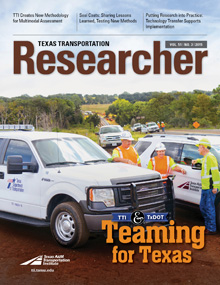In 2014, the Texas Department of Transportation (TxDOT) supplemented its Cooperative Research Program with an Innovative Projects program aimed at proactively addressing issues before they become problems. TxDOT’s Research and Technology Implementation Office (RTI) is overseeing 13 forward-thinking research efforts aimed at creating a safer, more efficient Texas transportation system. The Texas A&M Transportation Institute (TTI) has been awarded contracts to work on seven of those projects.
“Our work with TTI is a collaborative effort that leverages the research expertise and unique facilities of the Institute in a proactive rather than reactive way,” says RTI Director Dana Glover. “The Innovative Projects program will benefit Texans by exploring and evaluating state-of-the-art ideas and next-generation technologies. The program also will help us address the infrastructure needs of our growing population, which will continue to increase the number of vehicles on our roadways.”
1. The Truck Platooning Demonstration Project

1. The Truck Platooning Demonstration Project is creating a first-of-its-kind, comprehensive freight platooning demonstration in Texas. Truck platoons offer the potential for faster, safer and more environmentally friendly freight movement. This three-phase project will conduct a feasibility planning study and proof-of-concept demonstration, develop the requirements for design, and develop a commercial truck platooning application in Texas.
2. Automated and Connected Vehicle (AV/CV) Test Bed to Improve Transit, Bicycle and Pedestrian Safety

2. Automated and Connected Vehicle (AV/CV) Test Bed to Improve Transit, Bicycle and Pedestrian Safety is evaluating AV/CV applications for enhancing transit, bicycle and pedestrian safety. Thus far, TTI has held meetings and workshops with modal stakeholders and conducted a technology scan to identify four near-term applications, three of which focus on collision avoidance with turning transit vehicles, straight-line travel, and fixed objects. A fourth application is addressing bike-rack-on-buses safety. The concept-of-operations plan, which includes recommendations for implementing these technologies, is currently under development.
3. Connected Vehicle (CV) Wrong-Way (WW) Driving Detection and Mitigation Demonstration

3. Connected Vehicle (CV) Wrong-Way (WW) Driving Detection and Mitigation Demonstration is developing a concept of operations, functional requirements, and high-level system design to test applications that can detect and notify TxDOT and law enforcement about WW driving events. Researchers are also looking at how to alert the WW driver and nearby traveling public about such events. The project will include the demonstration and evaluation of a WW driving CV test bed in both a closed environment and at least one TxDOT district.
4. Strategy- and Technology-Based Approaches to Freight Distribution

4. Strategy- and Technology-Based Approaches to Freight Distribution is examining innovative and automated freight distribution methods and technologies to provide TxDOT with recommendations on which approaches hold promise for streamlining operations and reducing costs for freight carriers in Texas. Currently under review are 57 strategies and technologies to improve productivity, convenience and safety of other transportation system users, and public/private financial and economic impacts. Researchers are creating a tool box that identifies the most effective combination of freight technologies and strategies to maximize benefits for specific freight-system needs and locations.
5. Using Nondestructive Technologies to Ensure Specification Compliance for Pavements

5. Using Nondestructive Technologies to Ensure Specification Compliance for Pavements is exploring new methods for testing pavement materials using nondestructive technologies. Such technologies allow for minimal traffic disruption and an increased level of testing coverage, and offer the potential for increased pavement life. Focus elements included in the project, if demonstrated feasible and implementable, would make the responsibility of assuring quality construction for flexible and rigid pavements more timely and reliable with minimal disruption to traffic.
6. Piezoelectric-Based System for Harvesting Energy from Roadway Infrastructure

6. Piezoelectric-Based System for Harvesting Energy from Roadway Infrastructure is a project to develop a Highway Sensing and Energy Conversion (HiSEC) module to be embedded in pavement structures. The module is designed to harness the high dynamic forces created by vehicles and use them to generate electric power. In addition, the HiSEC module will provide continuous monitoring of the roadway’s conditions to help identify maintenance needs.
7. Developing New Technologies to Improve Infrastructure Maintenance

7. Developing New Technologies to Improve Infrastructure Maintenance is evaluating how emerging technologies can be used for more efficient and effective maintenance of highway infrastructure. Researchers are conducting proof-of-concept demonstrations in three highway infrastructure areas: safety and operations, bridges, and pavements. For example, adding sensors to existing infrastructure can give agencies responsible for maintaining it more timely data about needed repairs. Sensors can also improve the reliability of information provided by camera-based vehicle technologies to help keep vehicles on the road.

